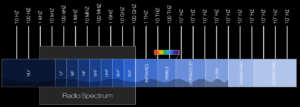- What are the elements of communication systems? Explain with classifications of communication systems
- What is the Frequency Spectrum of Communication Systems? Why Modulation is necessary in wireless transmission?
- What is Amplitude Modulation? Complete Mathematical Derivation of AM Wave
- What is the Importance of Side Bands in Amplitude Modulation? What are the types of AM?
- What is Frequency Modulation? Explain the process with diagram and mathematical analysis
- What is Satellite communication? Give Detailed explanation with diagram and mathematical analysis
Definition: Frequency modulation is defined as the process, in which the frequency of carrier signal is changed in accordance with the amplitude of modulating signal.
To produce FM wave, a carrier signal of frequency fc is mixed with another low frequency modulating signal of frequency fm in a circuit known as frequency modulator. To understand how frequency modulation process takes place, consider following diagram –

Relation of FM Wave with Modulating Signal
Suppose we have a modulating signal of frequency fm and a carrier signal of frequency fc. Now in FM process, the amplitude of carrier signal changes in accordance with the changing amplitude of modulating signal.
So there three possible conditions during this process, as follows –
- When amplitude of modulating signal is zero, the frequency of carrier signal remains the same i.e. fc known as center frequency.
- When amplitude of modulating signal is at positive peak, then the carrier signal frequency increases to fmax.
- When amplitude of modulating signal is at negative peak, then the carrier signal frequency decreases to fmin.
Thus the frequency of carrier signal swings between two limits fmax to fmin. Also when frequency of modulating signal is more, rate of carrier frequency swing is also more.
Important Definitions
Read these definition to understand the process of FM in details…
Frequency deviation
The amount of change in carrier frequency produced by modulating signal is called as frequency deviation Δf of the system.
Modulation index
The ratio of frequency deviation Δf to modulating frequency fm is known modulation index. It is given as –
m = Δf / fm
Percentage modulation
The percentage modulation is the ratio of actual frequency deviation to the maximum carrier deviation.
%m = Δfobserved / Δfmax = Δfobserved / 75kHz
In today’s modern FM radio stations, the value of Δfmax = 75kHz
Sidebands
Unlike AM, there is large number of sidebands in FM. The number of sidebands depends on the amplitude of modulating signal.
Ideally FM has infinite number of sideband pairs i.e. both upper and lower sidebands. Their frequencies are fm, 2fm, 3fm, 4fm, 5fm . . . and so on, as shown in the following diagram.

Comparison of AM & FM
| Amplitude modulation | Frequency modulation |
| AM signal contains lots of noise. This noise also depends on weather conditions. | FM gives noiseless reception. It quality of sound is better. |
| The coverage area of AM transmission is more. | The coverage area of FM transmission is less. |
| Fidelity is less. | Fidelity is more. |
| High quality transmission is not possible. | So high quality (Hi-Fi) transmission is possible. |
| Adjacent interference is present. | Adjacent interference is absent. |
| AM wave can refract through ionosphere. It bends and comes back to earth to cover large area. | FM wave cannot refract through ionosphere of earth glob. It goes straight into space, without bending. |
| AM wave can travel beyond horizon of the globe. | FM wave can travel only up to line of sight distance. |
| The bandwidth of AM is very small. | The bandwidth of FM is very large. |




Do you have article on AM?
Please reply